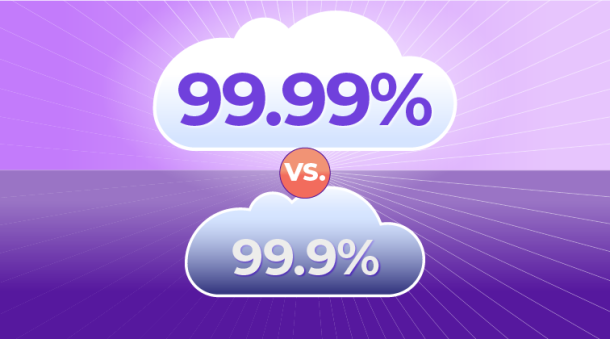Thanks to the cloud, our applications, platforms, services and even media are easier to access than ever. As long as you have an internet connection, you can log into a system that saves your work, or your spot in that Netflix movie, for a consistent experience across all your devices.
Yet what happens when those services go down? Turns out, it can cost us quite a bit of money. For organizations relying on cloud solutions to get their work done, service downtime can lead to a productivity nosedive—and we don't have to tell you how that can impact your bottom line.
That's why it's so important to find a service you can rely on, one that can guarantee uptime and promise “high availability” -- but that’s where it gets tricky.
Many of us might not even know how to define "high availability." We can be misled by marketing copy claiming "99% uptime!" or even better, "99.9% uptime!" But what exactly does this figure mean? Let's take a closer look.
What is high availability?
When we talk about the guaranteed uptime of a service what we are really discussing is the availability of that service.
High availability refers to the accessibility of a system, solution or application that can operate without any interruptions for an extended period of time.
When we're talking about cloud services, availability will always be measured as a percentage. What we typically see is availability measured between 99% and 100%.
Therefore, any service with 100% uptime should be available 24/7/365 without interruption -- meaning a system that never fails. Now, this is pretty rare. But on the flip side, any service with availability under 99% should offer a little bit of a warning sign -- you may want to consider what about their service prevents it from reaching that 99% standard?
Four 9's vs three 9's
On the surface, the difference between 99.99% and 99.9% availability may not seem like much of a dramatic difference. But when you drill down into exactly what these figures mean, the real story begins to show.
Utilizing a simple uptime calculator, we can gain a better understanding of what these measurements mean:
| Availability | 99% | 99.9% | 99.99% |
|---|---|---|---|
| Daily | 14m 24s | 1m 26.4s | 8.6s |
| Weekly | 1hr 40m 48s | 10m 4.8s | 1m 0.5s |
| Monthly | 7hr 18m 17.5s | 43m 49.7s | 4m 23s |
| Year | 3d 15hr 39m 29.5s | 8h 45m 57s | 52m 35.7s |
As you can tell, the difference between 99.99% availability and 99.9% availability means an additional 7 hours of acceptable downtime for that service everywhere. That breaks down further to 1 minute and 26 seconds of downtime everyday, or 10 minutes and 48 seconds every week.
So, on the surface the difference between four 9's and three 9's might seem like, well just a single nine. But in reality, it can mean the difference between guaranteed service all year, or an acceptable 8 hours of downtime.
Calculating the cost of downtime
So what, you may be thinking. Only 8 hours out of an entire year? What's the big deal? Well, the big deal is how much it could cost your business.
According to Gartner, the average cost of network downtime is estimated around $5,600 per minute. Multiply that by 60, and you're at $350,000 per hour.
Now, let's multiply that again by the 8 hours of accepted downtime with a 99.9% guarantee.
$2,800,000. That’s right. $2.8 million.
Therefore, if your business's application or tools are unavailable for 8 hours per year, it might end up costing you over $2 million.
So, how can we make sure this doesn't happen? First off, find a provider that offers over 99.9% availability. But beyond that, this is where a Service Level Agreement will come in as your safety net.
Protect your investment with a Service Level Agreement
Life happens. It's as simple as that, and we can't always get around it.
Weather, natural disasters, ISP outages or cyber attacks are all examples of interruptions that can bring service down unexpectedly. That is why you'll want to search for a provider that stands behind their availability guarantee with a Service Level Agreement.
A service level agreement is a contract between the service provider and your business to define the expectations of the platform, the level of quality the service provides, and even availability of the solution.
SLA's will generally include specific agreements on availability and uptime of the service, and performance metrics or benchmarks to compare your business' experience against.
How Smartling ensures high availability
Through the use of our Global Delivery Network (GDN) translation proxy, Smartling is responsible for delivering our client's translated content to the end user. And since no one wants their brand website to go down, it's on us to make sure that never happens. With 99.99% uptime your Smartling-powered site will experience no more than 52 minutes and 35.7 seconds of downtime per year.
This has all been achieved through Smartling's unique architecture of the GDN. Thanks to Elastic Load Balancing from Amazon Web Services, as well as redundancies in our infrastructure, Smartling can ensure a reliable experience that can scale as traffic to your website changes.
By utilizing Elastic Load Balancers in particular, Smartling can even scale our along with your business as needs change, while maintaining our unparalleled 99.99% availability.
That's in major contrast from other TMS and content delivery platforms that simply promise 99.9%, or even less availability.
The Bottom Line
So, if you’re looking for a reliable, scalable and highly available platform for delivering your translated content, then look no further than Smartling. Chat with one of our experts today to learn more!








